Amy Clarke Moore
Amy Clarke Moore has been at the
helm of Spin Off magazine
for 8 years. Those 8
years have seen a lot of changes in the fiber world and
an explosion in the number
of people spinning. Amy has risen to the task of editing
the only print spinning magazine by listening to spinners,
and by immersing herself in the world of fiber.
Amy graciously
agreed to take a break
from her work, family and
art to answer a whole bunch of nosy questions I’ve
been dying to ask her.
Thank you, Amy!

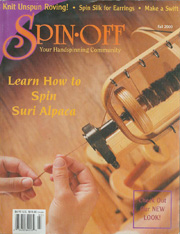 |
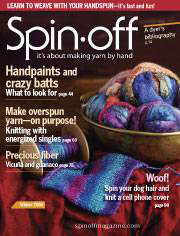 |
|
| Amy's
first issue of Spin-Off
from Fall 2000, and
her latest |
How long have you been editor of Spin
Off?
My first issue as editor
was the Fall 2000 issue,
but in the Summer 2000
issue, I was a guest editor
with Rita Buchanan—and
that is when my training
began. I was really fortunate
to be taught by the best
craft editor out there.
Talk about the joys and challenges
of editing your magazine.
The joys of editing Spin-Off are so clear—I
get to work with authors
who I really respect and
admire to attempt to create the best magazine possible
for our readers. The team who creates Spin-Off (I
don’t
do this alone!) is really cohesive—we work well together
and each person on the team contributes the best of their
creative efforts. The challenges? Well—our readership
ranges from absolute beginner to incredibly advanced spinners—we
have spinners who want to know everything about the science
and mathematics of spinning to spinners who rely totally
on intuition to achieve the yarn they desire—it is
always a challenge to provide
a magazine that makes everyone
happy.
Spin-Off has changed
since you took over
What did you
change and what was your
intention for the change?
I think Spin-Off has
changed and at the same
time remained the same—just
like your friends change
and stay the same over
the years. In the eight+
years that I’ve
been editor, we’ve gone through a few redesigns—for
both content and visual
impact and our readers
have been very receptive to the changes.
Will there be more changes?
There
will always be more changes—but I guess I see them
as natural evolutions since Spin-Off responds to
the desires of its readers (so, let me know what you
think and what you want
in the magazine—I’m
listening).
| |
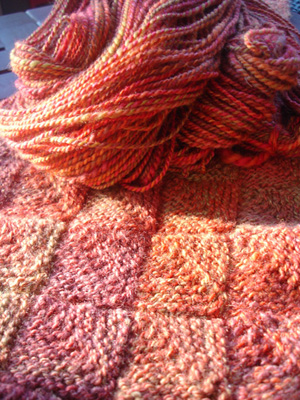 |
| |
Hannah"s Autumn Cardigan in progress two-ply yarn made from the Autumn and October colorways from Chameleon Colorworks, domino knitted. I had finished Hannah"s cardigan, but when I finally got it on her to see how it fit (by that point she was tired of trying it on) I realized that the neck was too big and it was falling off her shoulders. So, I"ve ripped it out and am nearly done reworking the neckline and button band but now I need more buttons. |
Why do you think more people are taking up spinning?
Learning
to spin seems to be the next step after
learning to knit for a lot of people—especially if you’ve
had a chance to work with handspun yarn.
There is something
that is so totally appealing
about the idea of being
able to design your own
yarn.
You
may not realize this
until you start spinning,
but spinning feeds the
crafter's need for instant
gratification. Really.
You can spin yarn for
a project in an evening
(depending on the project,
of course); that
same project may take days,
weeks, months to knit.
And
spinning is so relaxing
(well, once you get the hang of it)—so many people
turn to spinning when
they need a calm space
in which to retreat.
How
do you balance work/art & mommyhood?
Balance
is the key. I try to keep
focused on the important
things and not worry too
much about the small things.
I love the time
I get to spend with Hannah
(my three-year-old daughter).
We do a lot of things
together—work in the garden,
fold the laundry, wash
the dishes. It’s all
fun as long as we’re doing it together and that
way we get things done.
Since my husband
also works full time,
we’ve divvied
up the chores and it seems
to work most of the time.
Since Hannah came along, the time I spend on my artwork
is less, but I still work on it, it just takes longer
to make a piece.
Tell us about your spinning life
I learned how to spin while I was a student abroad in Costa Rica—I lived in a remote indigenous village with a spinner, weaver, dyer who taught me how to do all those things.
Actually, I
was motivated to learn
how to spin because her family thought it was outrageously
funny that I was 22 years old and didn’t know how to spin. The more they laughed
at my attempts to spin
cotton on a handspindle, the more I was determined to
learn. I did and I discovered a lifetime love.
I ended
up getting an MFA in
Fibers from Colorado State University and my thesis was
composed of over 40 handspun, handknitted dysfunctional
socks (you can see some of them in my Ravelry projects
page).
It was while I
was making these socks
(some big enough for
sleeping bags) that I thought, “hey,
I could make sweaters!”.
Any gear you’re
dreaming about getting?
I just visited
the Home Textile Tool Museum
in Orwell, Pennsylvania and
tried out a pendulum wheel—and instantly
wanted one—even though it would be totally impractical.
| |
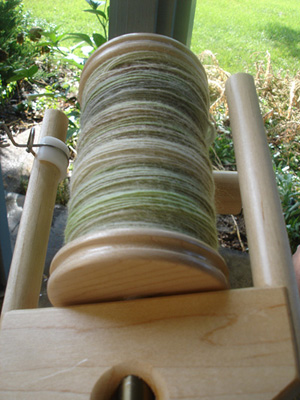 |
| |
Spunky
Eclectic BFL Estuary
on my Lendrum—to
be Navajo plied into
a nice squishy yarn
for a domino-square
baby blanket.
|
What’s your
favorite fiber to spin?
Wool. I’m really enjoying spinning with BFL right
now—but also, Shetland and Polwarth—it depends
on the project.
What do you do with your
handspun?
I have several projects
in the works—tussah silk
dyed with indigo for a
cardigan, BFL dyed by Spunky Eclectic for a domino-square
baby blanket, BFL dyed by Chameleon Colorworks for a domino-square
sweater for Hannah (it was done, but then I decided to redo
the collar), several fleeces that I’m scouring in
small batches as I have time, and many more projects that
are just waiting in my cedar chest for time to spin.
Though
I’ve been spinning
for many years—I don’t get large chunks of time
to really work on it—so I’m still an intermediate
spinner. I keep my wheel
in my living room and the current projects in cloth-lined
baskets under a table—so it
is easy to pull out when
I have time.
Many folks may not know that you
are a bead artist. How did you start
and what types of things
do you do?
I started beading while
I was working as an editorial
assistant on Beadwork magazine at Interweave
for a staff project on
bead embroidery. I got
hooked and didn’t look
back. I bead over photographs
using a spiraling backstitch
and use this medium to explore
my love of fairytales and
myths. See more of Amy’s
work here.
What are you working on right now?
I’m
finishing up a beaded piece
about Lady Godiva right now (it seems so perfect for an election year
to be working on this piece depicting Lady Godiva, whose famous bare-back
ride through town was a
very creative way to convince her husband to give relief to the overtaxed
citizens of their town).
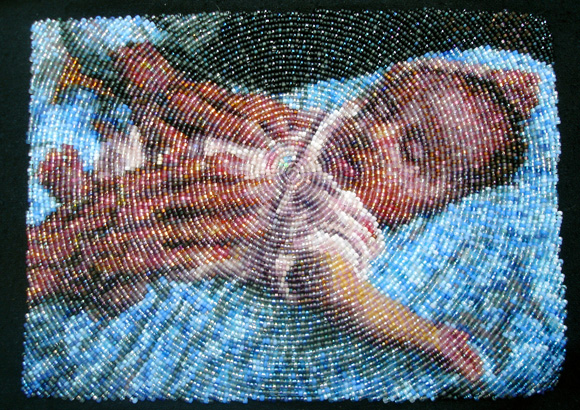 |
|
| This
is my most recently
completed beaded
piece—Hannah
in Helen’s
Hands. Normally I
bead over photos
that I’ve taken,
but this is one that
my sister took (I
got her permission
to use it) of my
Grandma Helen holding
Hannah shortly after
she was released
from the hospital. |
|
What inspires you in work/life/art?
Why is this a hard question?
Is it because inspiration
comes from so many sources?
I’m inspired by the people
in my life, and people
I’ve never met, but whose stories
I’ve heard, I’m inspired by the art I’ve
seen, the books I’ve read, the natural and human-made
world around me.
Can you give me 3 tips for
spinners?
Trust
your instincts.
Spin yarn that makes you
happy.
Don’t worry about the shoulds.
|



